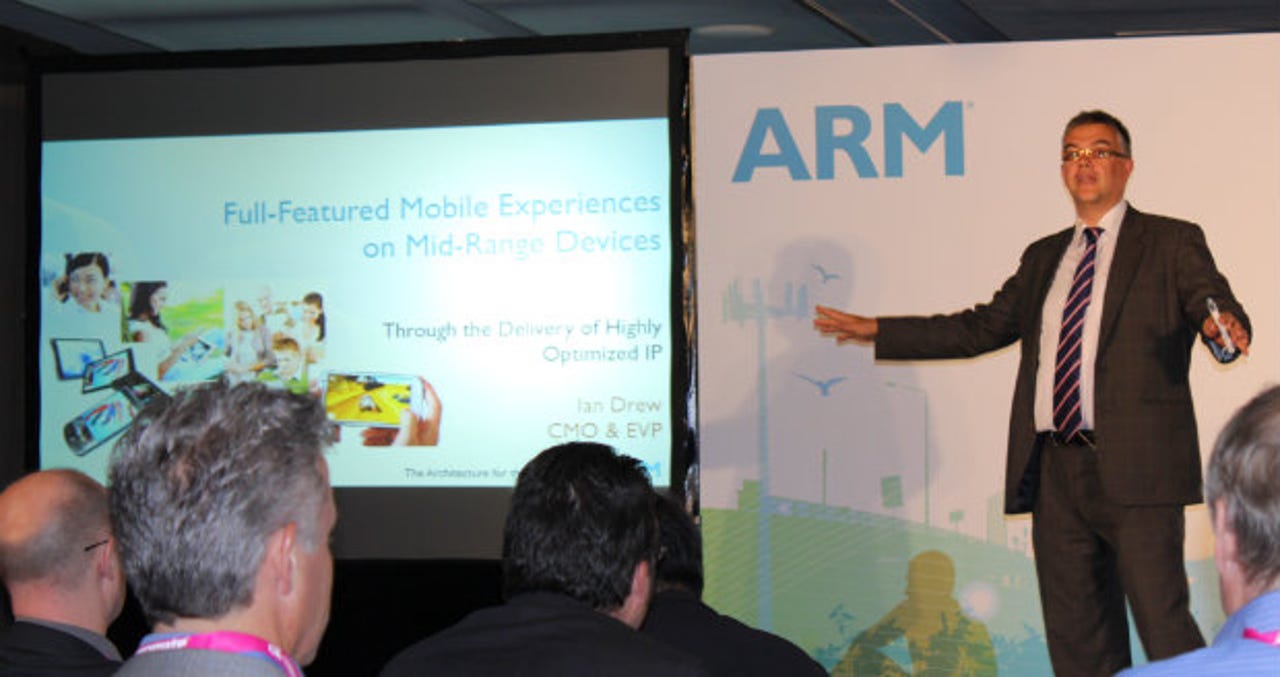Computex 2013: ARM announces mid-range A12, 'sets record straight' on Intel's Silvermont


The hero phones get all the glory. But ARM, the company behind the chips that power the world’s smartphones, believes that the mid-range — smartphones that cost $250 to $350 before subsidies — is where the fastest growth will be in the next few years. On the eve of the Computex tradeshow in Taiwan today, ARM announced several new products, including the Cortex-A12 processor, designed for this mid-range market.
“Today I want to talk to you about how the mobile industry is going to change,” said Ian Drew, ARM’s chief marketing officer and head of business development. “I want to talk to you about how the mid-range is going to explode.” The industry will ship more than a billion smartphones this year, and he said ARM expects that by 2015, the mid-range will grow to 500 million units per year.
The A12 fits in between the Cortex-A15 for high-end smartphones and tablets and the Cortex-A7 for low-end mobile devices. It also gives ARM’s customers something to replace the Cortex-A9, which was once the engine behind high-end mobile devices but is starting to look old. ARM said the A12 will be 40% faster than the A9 at the clock frequency thanks to a new, 11-stage pipeline design and improvements in the memory system. Some chipmakers such as Samsung are using both the A15 and A7 in the so-called big.LITTLE arrangement, but ARM said the A12 will initially be used on its own in dual- or quad-core processors for smartphones that will start shipping toward the end of 2014.
In addition to the A12, ARM announced the Mali-T622 graphic processor, Mali-V500 video IP and processor optimization packs (PoPs) with physical IP that makes it easy for customers to rapidly design and manufacture chips using the current 28-nanometer process. This is the first time that ARM has announced at the same time a complete suite of processor cores and IP targeted to a particular market. Drew talked about the importance of delivering the whole system — performance, price, power, software and graphics — tuned to the right segment. He said this will enable high-end features such as video editing, speech and handwriting recognition, and facial recognition in mid-range smartphones.
On its own, the Mali-T622 is 50 percent more power-efficient than the Mali-T600, according to ARM, but it is also designed to share compute workloads with the CPU cores to save overall system power. ARM said the OpenGL ES 3.0 Mali-T622 is the world’s smallest GPU Compute solution with support for the Renderscript and OpenCL APIs and cache coherent memory. The Mali-V500 is a dedicated hardware video processor that scales from a single core for 1080p video encoding and playback at 60 frames per second to multiple cores for 4K video at up to 120 frames per second. It also extends ARM’s TrustZone security features to video processing to make it easier to securely deliver high-definition video content to mobile devices.
ARM announced Cortex-A12 CU and Mali-T622 optimization packs for TSMC’s 28HPM process and an A12 pack for GlobalFoundries 28nm-SLP process. In a separate press release, GlobalFoundries stated that a Cortex-A12 processor manufactured on its 28nm-SLP will deliver up to 70 percent better performance and up to 2x lower power than a current 40nm Cortex-A9 processor. ARM executives also hinted at “other variants of 28nm,” which most likely refers to FD-SOI, an alternative technology that STMicroelectronics and GlobalFoundries are developing.
Intel’s recent announcement of the Silvermont Atom microarchitecture clearly irked ARM, and in response to a question, company executives were prepared with slides designed to “set the record straight.” Noel Hurley, VP of ARM's Processor Division, showed a slide indicating that the Cortex-A15 and Cortex-A7, manufactured on a 28nm process, were already outperforming Silvermont on Intel’s 22nm FinFET process, which won’t start appearing in tablets and smartphones until early 2014. He said 20nm and 14nm/16nm — the first node with 3D FinFET transistors — won’t be far behind and that ARM had a big edge with its hardware and software ecosystem. ARM said it has more than 50 customers designing chips using its technology and 60 percent of the top apps use ARM native code.